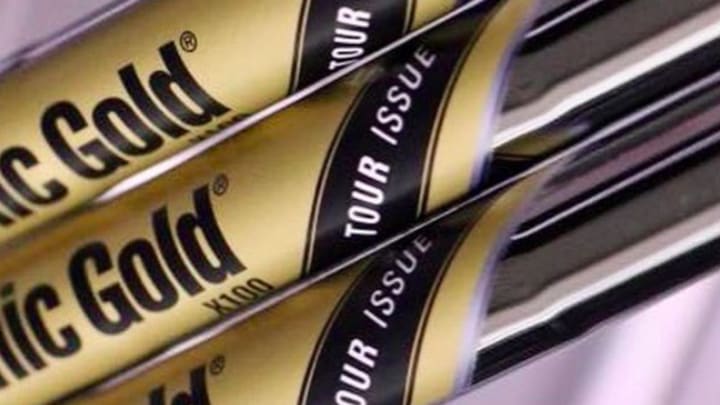Celebrating True Temper’s Dynamic Gold standard

Golfers have grown accustomed to a steady flow of technological innovation in all categories of golf equipment, as the game’s manufacturers introduce new products annually. From balls to irons to metalwoods, grips, gloves, rain gear, shoes and cleats, and even golf tees, the game’s newest gear uniformly promises longer and straighter shots and lower scores.
That said, True Temper’s Dynamic Gold line of golf shafts has gone virtually unchanged since being introduced in 1980. Today, it remains the No. 1 iron and wedge shafts choice on the PGA Tour.
Actually, this remarkable story of survival and endurance can be traced to 1940, when True Temper developed its Dynamic line of shafts. At the time, the line represented the most advanced steel shafts manufactured since replacing hickory wooden shafts of the mid-1920s.
For the first time, Dynamic offered shafts in a range of flexes, including regular, stiff and ladies. The shafts also featured a step-down pattern that enhanced feel and reduced the excessive torquing and twisting of previous wooden shafts. These rather stout Dynamic iron shafts offered a well-balanced swing feel, consistent and stable ball-turf interaction, and the kind of controlled shotmaking that all of the game’s greats — dating as far back as Byron Nelson, Sam Snead and Ben Hogan — required.

In 1980, True Temper (the company, originally called The American Fork and Hoe Co., was founded in Ohio in 1902) changed its model’s name from Dynamic to Dynamic Gold, which indicated that the company had started sorting its shafts into groups of tighter weight tolerances. These groups of similar shaft weights now form the R300, S300, S400 and X100 flexes that are well-known today.
The company’s Dynamic Gold Tour Issue S400 and X100 versions represent the most tightly sorted shafts and are the model vastly preferred by the current crop of PGA Tour players. While True Temper, for more than a decade, has developed lighter versions of Dynamic Gold shafts, including those weighing 95, 105 and 120 grams (versus the nearly 130 gram weight of the original versions), the essential foundational design of the line’s original Dynamic shaft hasn’t changed at all.
So what accounts for this octogenarian’s phenomenal success?
“The Dynamic Gold shaft is extremely neutral in all regards … mid-balance point, mid-kick point, just about mid-trajectory … which means it can accommodate all types of swing styles and shaft loading techniques,” said Kouros Kou, a respected club builder and fitter who owns and operates the Roland Heights-based Korous Logic Golf in Southern California. “By not independently adding extra launch angle, ball speed or spin to the ball, these shafts allow golfers to use their skills in hitting the shots they want rather than depending on theirs shafts to do so for them.”
Todd Beach, TaylorMade Golf’s Senior Vice President of Research Design and Engineering, offers another reasonable insight into Dynamic Gold’s enduring popularity and use among today's elite players, including Tiger Woods, Dustin Johnson, Justin Thomas, Matt Wolff and Collin Morikawa.
“A lot of these golfers grew up using Dynamic Gold shafts in their irons,“ Beach said, “so if they wanted to keep the same feel and consistency in their shafts as they grew older and stronger, they could easily progress from the Dynamic Gold regular flex of the junior years into the stiff and then the extra-stiff versions by the time they got onto the PGA Tour.”
As Don Brown, True Temper’s Vice President of Innovation and Product Creation, says: “Many have tried to ‘topple the King,’ but none have succeeded.”
The Dynamic Gold S300 remains the stock workhorse version of the line that is selected by many equipment companies for their forged blades and other high-performance players’ irons.
Why do you swing Dynamic Gold? @PReedGolf explains his choice 👇 pic.twitter.com/m5p3ZG5T35
— True Temper Golf (@truetempergolf) January 6, 2021
The lighter versions of the Dynamic Gold line represent a good choice for stronger-lofted, longer-flying, game-improvement irons. Coupled with their more flexible bend profiles, these models of Dynamic Gold shafts provide the extra initial launch height and spin rates that the stronger-lofted clubs for some players do not deliver. According to Brown, these shafts still provide players with the same smooth and balanced swing feel and dependable stability and strike through impact as do the other irons in the Dynamic Gold line.
The 20th century Spanish poet Antonio Machado once wrote that “everything changes and everything stays the same.” TaylorMade’s Todd Beach corroborates this nugget of wisdom through the unlikely narrative of golf shaft evolution.
“Some years ago, I did a presentation that showed that Bobby Jones’ hickory shafts had a very similar stiffness bend profile to the Dynamic Gold line of steel golf shafts. Indeed Jones’ wooden shafts were very similar in weight as well — in the range of 120 to 130 grams — to today’s Dynamic Golds.
“The main difference was that the hickory shafts had a very high (soft) degree of torque. This required players of Jones’ time to swing more smoothly and with greater hand action than players using all models of steel shafts in play today. Contemporary steel shafts such as True Temper’s Dynamic Gold line allow golfers to attack the ball more aggressively through impact if they so choose.”
An 81-year-old golf shaft attacking the ball as aggressively through impact as Tiger Woods, Justin Thomas and Dustin Johnson? That’s progress.
Sign up to receive the Morning Read newsletter, along with Where To Golf Next and The Equipment Insider.
